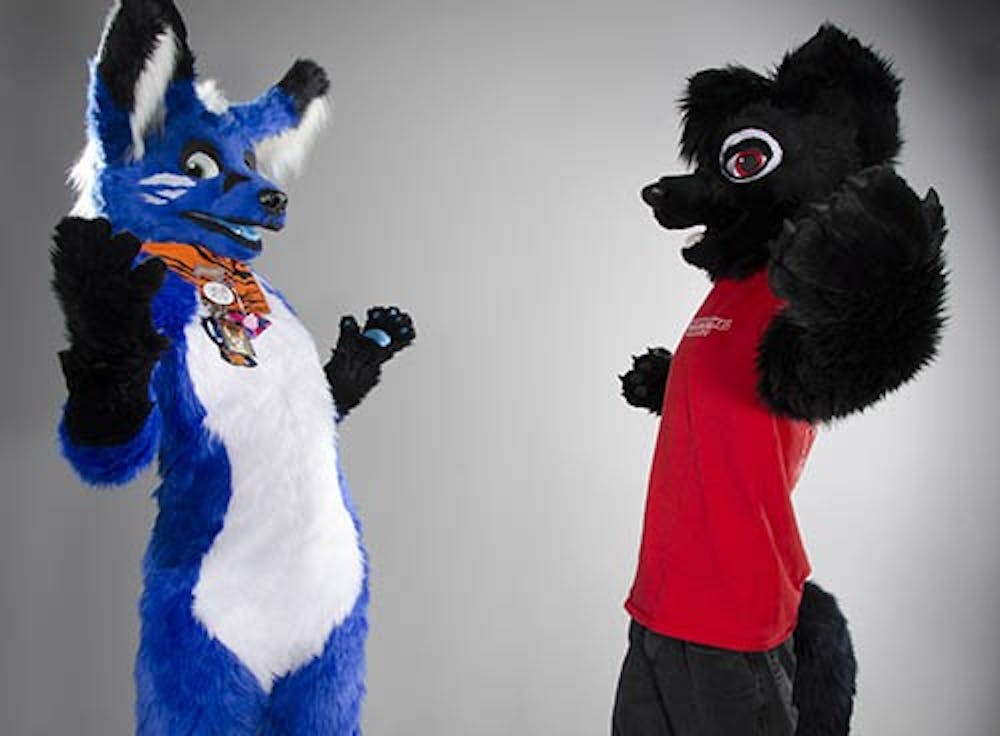Albert DiBenedetto entered room 301 in the Student Center dressed in all black. From the tips of his Belgian shepherd ears, to the hem of his dark, denim jeans, DiBenedetto was engulfed in his fursuit.
A fursuit is an animal costume that directly represents his furry persona, or fursona.
His black shirt blended into the black fur of his headpiece and fur covered paws. Adding color to his fursuit is the white border around his eyes, and a plush taco, an accessory DiBenedetto is rarely seen without.
“[The taco] doesn’t really hold a meaning beyond the fact that I just really enjoy tacos,” DiBenedetto said. “It’s just a part of my fursona.”
DiBenedetto, a junior physics major, is a member of Ball State’s Anthropomorphic Art Society (AAS), a club of artists and art enthusiasts who meet weekly to discuss anthropomorphic art.
Anthropomorphic art combines animal and human qualities. Tracing history back as far as the Egyptian’s hieroglyphics of deities with human bodies and animal heads, it’s hard to pinpoint an origin of this art. The history and impact it has on society is one aspect that AAS discusses in its weekly meetings.
The first club meeting had less than 10 people sitting around a small table. Since then, the club tripled their numbers with more than 30 people showing up regularly to weekly meetings.
“The main goal of the club to get together, learn a little bit and discuss the art,” AAS President Vance Yaunt said. “We are such a unique group of people with very different reasons why we love anthropomorphic art.”
After learning about furry culture from a past girlfriend, DiBenedetto started out dipping his toes into the fandom by building his fursona his freshman year of college. It wasn’t until the beginning of August that he started fursuiting as Seneca, the name of his fursona.
DiBenedetto spent months coming up with a story and concept for his fursona. He described Seneca as being “very derpy and goofy” while being “incredibly personable and caring.”
He then started figuring out how much it would cost to get a partial fursuit complete with head, paws and feet. After asking around and coming up with the best price for the quality, he spent roughly $900 on his partial fursuit.
A full body fursuit can range in price anywhere from $1,500 to $3,000. After he paid the fursuit creator, he stayed in contact to give insight to his fursona.
After months of planning, pricing and waiting, DiBenedetto received his fursuit in the mail on the morning of Aug. 9.
“When it arrived I pulled it out of the box and immediately put it on,” he said. “I was going to a convention that day, so I really got to put the suit to good use just hours after receiving it.”
His first day in the fursuit, DiBenedetto spent eight hours walking through lobbies and hallways at the convention guided by his handler, someone who helps fursuiters navigate while they are in costume because their vision and range of motion is confined.
He quickly realized how hot the suit can get.
“I definitely sweat a lot in the suit,” DiBenedetto said. “A lot more than I anticipated, but it is well worth it.”
He became a fan of the Headless Lounge, a cool-down room for fursuiters to take off their costume heads and relax.
While DiBenedetto was proudly displaying his new fursuit, Shawna Gardner, a senior art major, was selling her art at the convention’s Artist Alley, which is a place to sell personalized art and network with furry fans.
Gardner has turned her love for anthropomorphic art into a business.
Selling her art to a specific group of people has given Gardner the opportunity to raise her prices and make money through an outlet that she is passionate about.
“Depending on the size of the convention I can walk away selling 16 to 29 different pieces a day,” Gardner said. “It not only gives me the opportunity sell my art, but to continually challenge myself to make something different.”
Gardner started AAS her first semester at Ball State in 2009. She wanted to start something where lovers of the art could meet, create and discuss the different aspects of anthropomorphic art.
“It’s kind of my joy and my treasure, I’ve loved watching it grow and seeing everyone in it,” Gardner said.
To many in the club, it is more than something to do on Thursday nights, it is a place for them to be themselves and meet people they can connect with. For Brock Goodwin, a junior urban planning major, it was an added bonus to his transfer from Rose-Hulman Institute of Technology in Terre Haute, Ind.
Goodwin knew about the club before his transfer, and made sure he attended all the meetings he could as soon as he became a Cardinal.
“It’s a place for us to get together and share something we all love, and in turn find a community that is 100 percent accepting of everyone,” Goodwin said.
The club is out to combat the negative connotation associated with fursuiters.
“We have this link with being a sexual group of people, and it is not true,” Goodwin said. “We have been trying to pull away from that image, and show people that we focus on expressing ourselves through art, not sex.”
AAS meets at 9 p.m. every Thursday in the Student Center. Check out its Facebook for more info about meetings at facebook.com/BallStateAAS.


